Muscle Insider
New member
The gluteus maximus — that’s your butt for the uninitiated — is the largest muscle in your body. Even if filling out a pair of jeans isn’t at the top of your priority list, bigger, stronger glutes will help you build better squats, deadlifts, and everything in between (yes, even overhead lifts). If you can’t figure out the most efficient...
The post The 17 Best Glute Exercises for Size, Strength, and Activation appeared first on BarBend.
The gluteus maximus — that’s your butt for the uninitiated — is the largest muscle in your body. Even if filling out a pair of jeans isn’t at the top of your priority list, bigger, stronger glutes will help you build better squats, deadlifts, and everything in between (yes, even overhead lifts). If you can’t figure out the most efficient way to activate your glutes, you’re just not going to be able to maximize your gains.
Here, you’ll learn why direct glute workout is more effective than the old “well, glutes are involved in squats and deads, so that should be enough.” If you really want to boost your performance in and out of the gym, you need the right glute exercises.
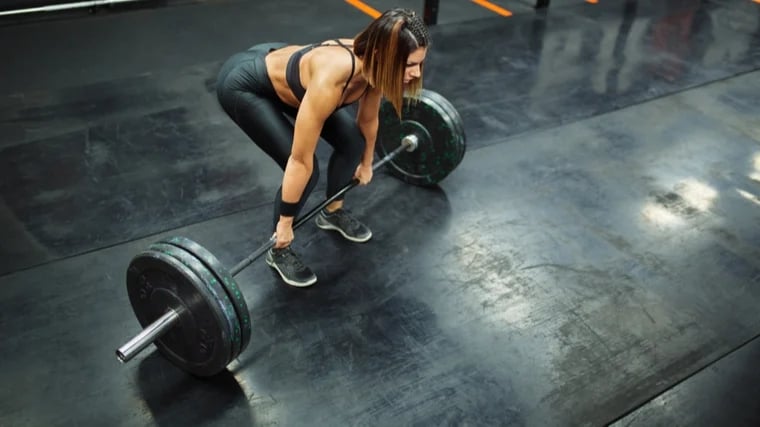 Credit: BigBlueStudio / Shutterstock
Credit: BigBlueStudio / Shutterstock
But how do you know which glute exercises are best? You read this list and put the movements into action. Here are 17 of the best strength-and-muscle-building glute movements you can try on your next leg day.
17 Best Glutes Exercises
[*]Conventional Deadlift
[*]Back Squat
[*]Hip Thrust
[*]Belt Squat
[*]Banded Romanian Deadlift
[*]Rear Foot Elevated Split Squat
[*]Sumo Deadlift
[*]Modified Curtsy Lunge
[*]Walking Lunge
[*]Cable Glute Kickback
[*]Step-Up
[*]Smith Machine Reverse Lunge
[*]Lateral Lunge
[*]Goblet Squat
[*]Single-Leg Glute Bridge
[*]Good Morning
[*]Kettlebell Swing
Editor’s Note: The content on BarBend is meant to be informative in nature, but it should not be taken as medical advice. When starting a new training regimen and/or diet, it is always a good idea to consult with a trusted medical professional. We are not a medical resource. The opinions and articles on this site are not intended for use as diagnosis, prevention, and/or treatment of health problems. They are not substitutes for consulting a qualified medical professional.
1. Conventional Deadlift
The conventional deadlift — the king of all deadlift variations — is one of the most popular exercises around, and rightfully so. It challenges the muscles around the hip, knee, and ankle. It also taxes the muscles surrounding your wrist, elbow, and shoulder to hold the barbell, but those joints do not contribute directly to the range of motion.
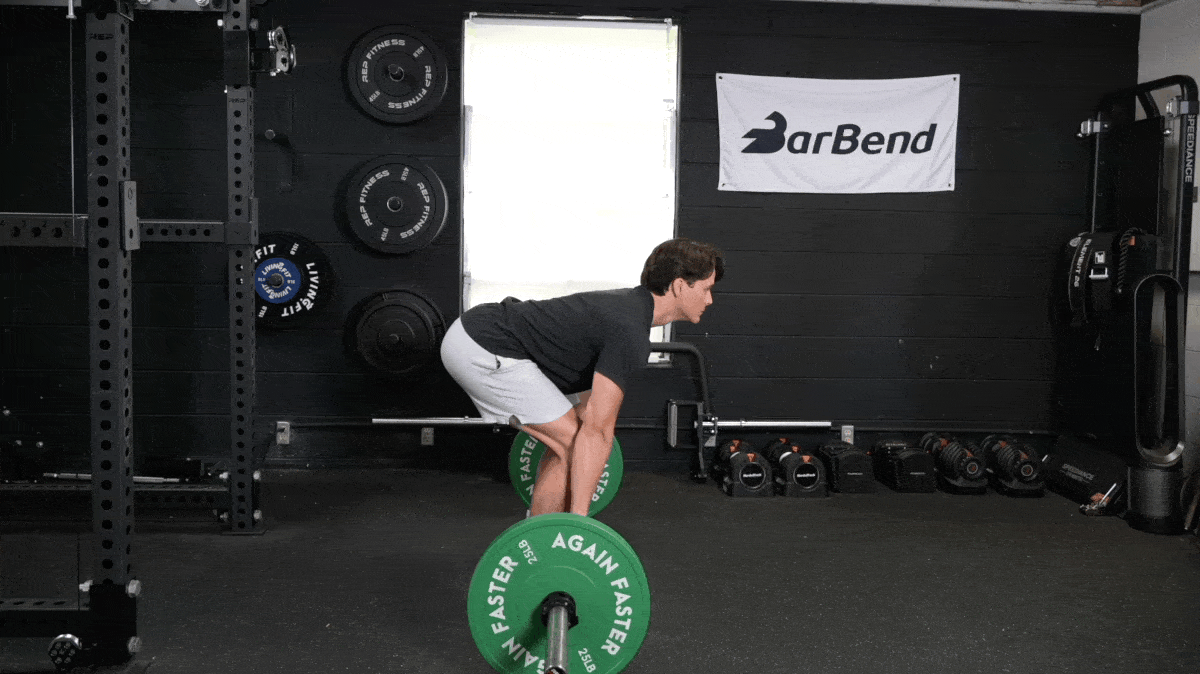
[Related More: Romanian Deadlift Vs. Deadlift — Which is Better for Your Program?]
As it has a primary focus on hip extension, you can do deadlifts while training back, legs, or anywhere else it fits nicely in your programming. The raw mechanical tension applied to your backside is unrivaled by most other weight room exercises as well.
How To Do It
[*]Set up for the deadlift by taking a hip-width stance, hinging at the hips, shooting your butt back, and reaching down to the barbell.
[*]Grab the bar with a close grip, just outside your shins.
[*]Flatten your back, pull your chest up, and take a breath in.
[*]Push into the floor with your legs to break the bar off the ground.
[*]As the bar passes your knees, thrust your hips forward and squeeze your glutes to come to a standing position.
Coach’s Tip: Take some time to experiment with your starting position to find something that really engages your glutes.
Sets and Reps: For glute growth specifically, try 3-4 sets of 5-8 reps.
2. Back Squat
The back squat is a compound exercise that challenges every muscle in the legs, especially the glutes. Its primary use in training is to challenge hip extension, driving the lower body up from the bottom position and placing a high amount of tension on the glutes.
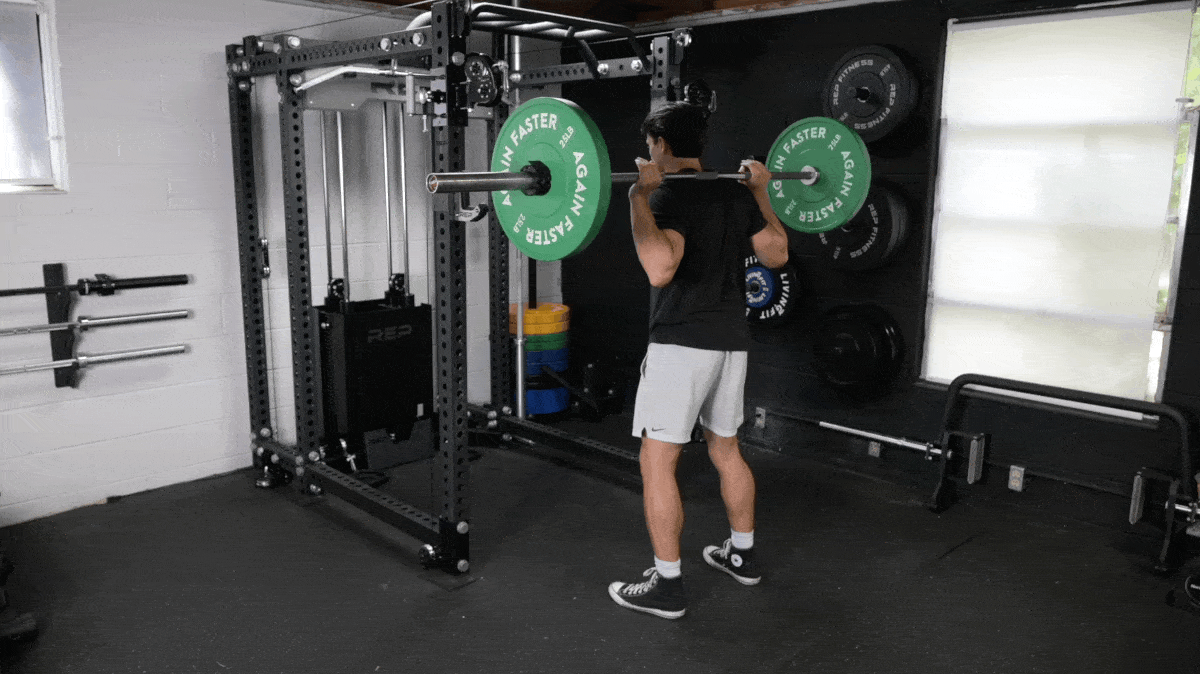
[Read More: The 8 Best Knee Sleeves You Can Buy]
The back squat leads to strength and muscle gain and reinforces other exercises like the deadlift, split squat, and lunge. It also recruits the core and improves your posture.
How To Do It
[*]Unrack a bar from a squat rack by placing it on your upper back with a close grip and taking one or two steps back.
[*]Take a comfortable stance; place your feet between hip and shoulder-width apart and turn your feet outward to whatever angle feels natural.
[*]From here, inhale into your belly and feel your weight distribute evenly across your feet.
[*]Squat by breaking at your knees and hips simultaneously and sitting down as low as you’re able.
[*]Once you reach the bottom, reverse the motion and stand back up by contracting your quads.
Coach’s Tip: Squat depth is the most important factor when it comes to engaging your glutes. Try to squat as low as you can with good form.
Sets and Reps: Go for 3-4 sets of 6-8 reps with a challenging weight.
3. Hip Thrust
This exercise is very effective at loading the glutes in their shortened position, without the need to load the spine. What separates the glute bridge from the hip thrust is the range of motion.
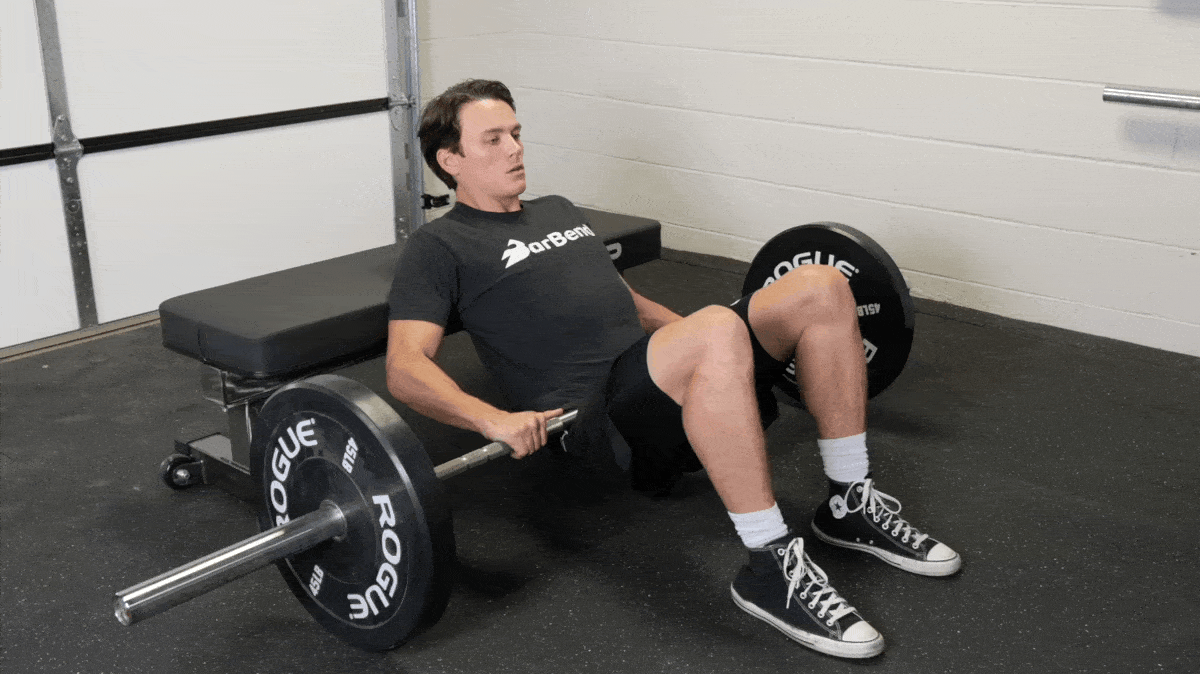
Folks typically perform glute bridges on the floor, which limits how much you can flex your hips and makes using heavy weights somewhat awkward. Hip thrusts require you to sit up against a bench and offer more range of motion to blast your glutes with. What’s more, thrusts let you apply lots of heavy tension to your glutes while leaving your lower back almost entirely out of the equation.
How To Do It
[*]Sit with your upper back against a weight bench and a loaded barbell in front of you. Roll the bar back until it brushes up your hips.
[*]Bend your knees and plant your feet on the floor to seal the bar into your hip crease. Grab the bar with a wide grip.
[*]Initiate the thrust by pushing your hips upward until your body forms a straight line from your kneecaps to your shoulders.
Coach’s Tip: You should absolutely place a protective pad on the barbell here to avoid crushing your hips and groin.
Sets and Reps: Do 4-5 sets of 8-12 reps here to grow your glutes.
4. Belt Squat
This unique squat variation uses a machine to help load the lower body, without the need to place more load on the low back and spine. It’s popular across all levels of fitness, including among bodybuilders, powerlifters, and weightlifters for building muscle and strength in the quads and glutes.
https://youtu.be/oAK7QmugOzUVideo can’t be loaded because JavaScript is disabled: How To Dramatically Improve Your Squat WITHOUT Loading The Spine | Matt Wenning Belt Squat (https://youtu.be/oAK7QmugOzU)
[Read More: The Big Guide to Muscle Hypertrophy]
The positioning of the load in the belt squat allows for a more vertical spine, taking some of the load off the low back, and increased training volume without more wear and tear since the weight is pulling your hips down rather than pressing on your torso.
How To Do It
[*]Stand on the platform and fasten the belt around your hips.
[*]Place your feet to the left and right of the pulley in the platform and place your hands on the handles in front of you.
[*]Engage the pulley system and find your balance. Take a breath into your belly.
[*]Sit straight down, allowing the pulley to guide your movement.
[*]Squat as low as you comfortably can and then push back up to a standing position.
Coach’s Tip: Think about allowing the pulley system to pull your hips straight down into the bottom of the squat.
Sets and Reps: Try 2-3 sets of 8-12 reps here with a moderate weight.
5. Banded Barbell Romanian Deadlift
This variation helps add tension to the glutes in the standing position — a position where there is usually no resistance. The resistance band helps give a counterbalance to your torso and allows you to lean forward into the movement. It also gives you an external cue to help you bend your hips rather than rounding at the low back, improving your hip-hinging abilities.
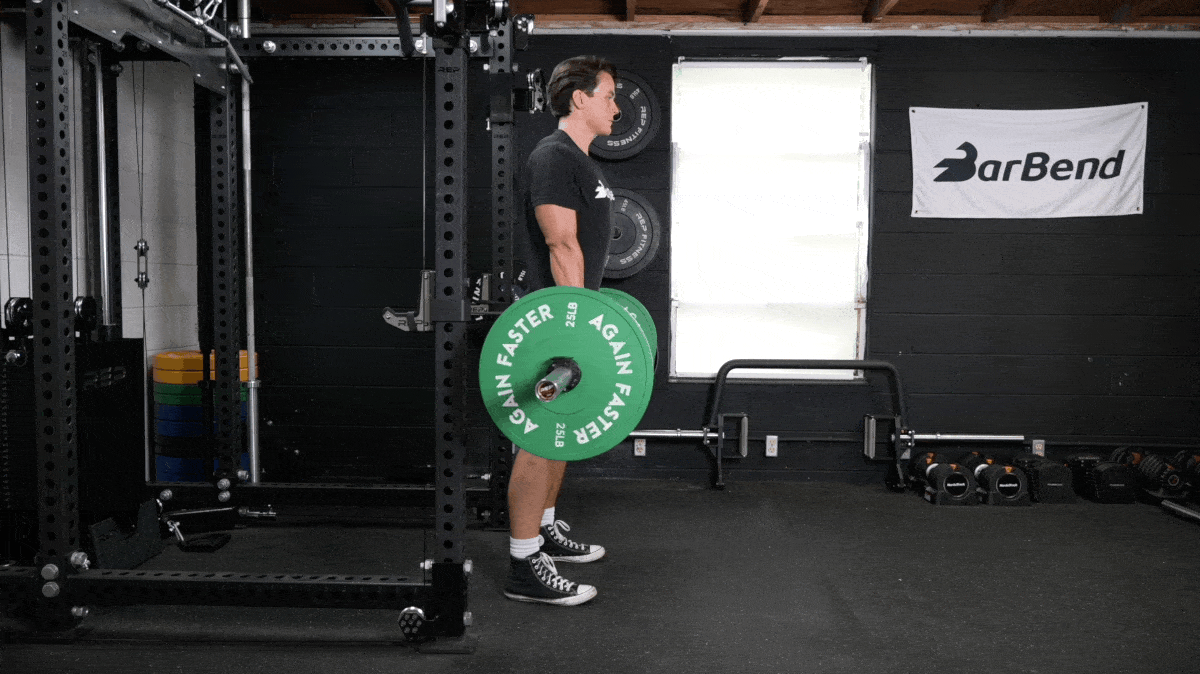
[Read More: The Single-Leg Deadlift Is the Best Pulling Accessory You’re Not Doing]
The horizontal band position can help increase the load placed on the muscles across the range of motion. You can also use the band as a tactile cue — it pulls your hips backward, naturally encouraging you to fall into a picture-perfect hip hinge, and adds some much-needed tension to the top portion of the exercise.
How To Do It
[*]Fasten a resistance band to a support structure at waist height behind you, wrap it around your hips, and step forward until there is moderate tension in the band.
[*]Bend over to pick up a lightly-loaded barbell and assume a close hip-width stance.
[*]Hinge at the hips, allowing the band to pull your pelvis backward until you feel a strong stretch in your posterior chain. Let the barbell glide down your thighs.
[*]Fight the band and thrust your hips forward to return to a standing position.
Coach’s Tip: The band should not be tense enough that you lose your balance. Use it to cue forceful hip extension.
Sets and Reps: Try 2 sets of 12-15 reps here with a moderate weight.
6. Rear-Foot-Elevated Split Squat
A close relative to the Bulgarian split squat, this variation isolates one leg at a time, which also allows a weaker leg the ability to catch up in terms of size and strength.
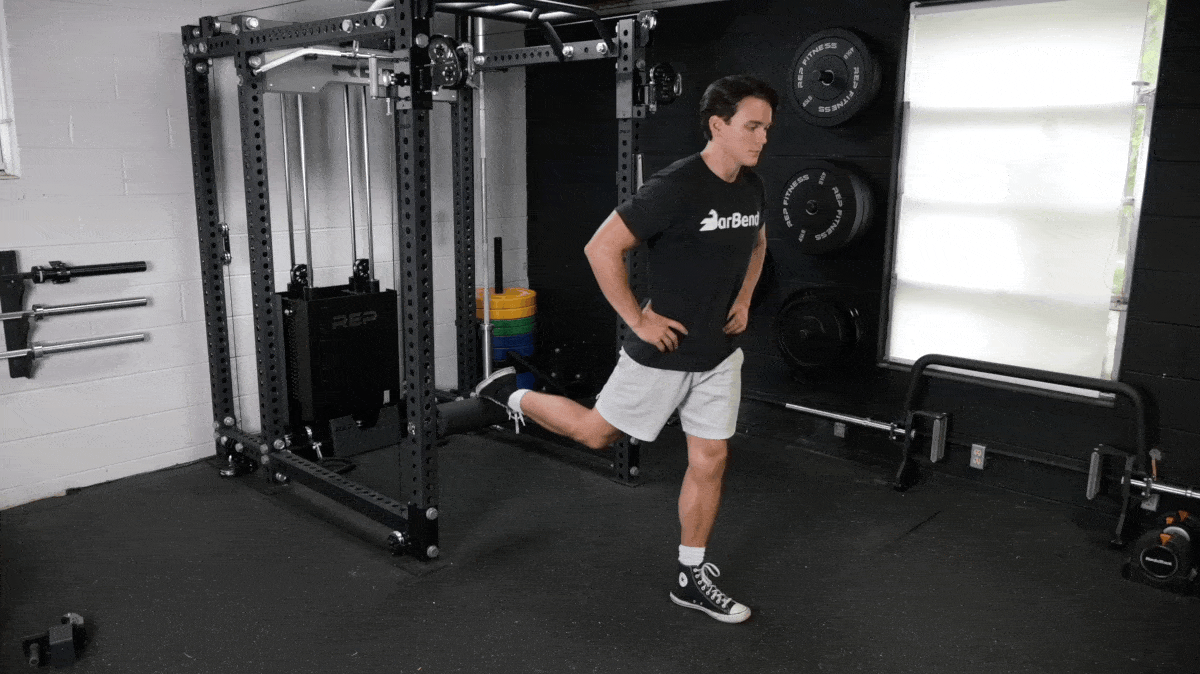
The rear foot elevation allows you to sink down into hip flexion more, placing more muscular tension on the glute of the front leg. It’s also a phenomenal exercise for identifying and attacking any side-to-side discrepancies in strength or motor control, improving your balance as you beef up your backside.
How To Do It
[*]Place your non-working leg onto a knee-height bench or box about two feet behind you.
[*]Balance yourself on your working leg with a weight in each hand.
[*]From here, sink your hips down and back, allowing your working leg knee to bend and travel forward as needed.
[*]Reverse the motion by pushing into the floor until your leg is straight.
Coach’s Tip: To emphasize your glutes even more, limit how far forward your knee travels over your toes.
Sets and Reps: Try 2 or 3 sets of 8 to 12 reps with as much weight as you can maintain good form with.
7. Sumo Deadlift
The sumo deadlift is a widely-used exercise with many benefits, especially when it comes to adding strength and size to the lower body. This deadlift variation requires a wider stance compared to the conventional setup, with the feet turned out quite significantly in some cases. Powerlifters “pull sumo” to lift the heaviest weights possible in competition, but it’s a darn good exercise for shaping your glutes even if you aren’t a strength athlete.
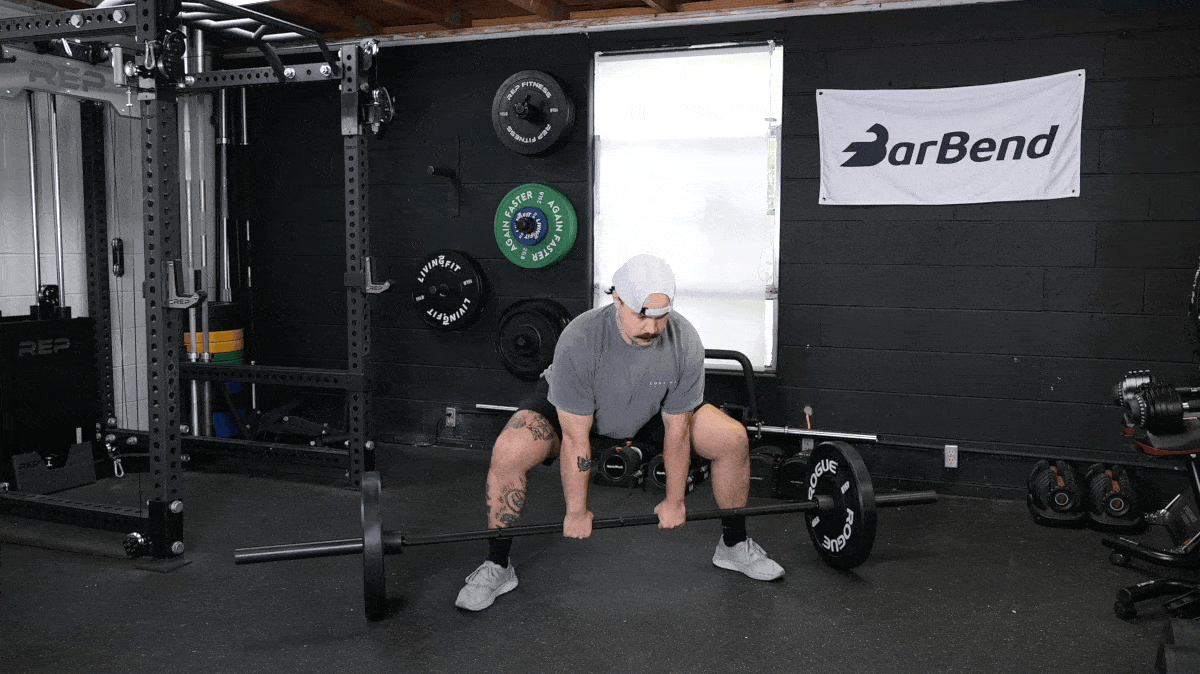
[Read More: Get Freakishly Strong With the 5×5 Workout Program]
The ultra-wide stance places the hips into external rotation, placing tension on the adductor and glute muscles — most notably the smaller glute medius and minimus. Most people can maintain a more upright torso with the sumo deadlift as well, which is beneficial if you want to minimize loading on your lumbar spine.
How To Do It
[*]Address a loaded barbell by taking a very wide, toes-turned-out stance. Point your feet towards the weight plates and open your hips.
[*]From here, break at the hips and sink down until you can grab the bar with both hands.
[*]Brace for the pull by inhaling air into your stomach, pushing your knees out to the sides, and pulling your chest up.
[*]Initiate the movement by pushing into the floor with your legs and standing up until you can lock your hips out.
Coach’s Tip: The sumo deadlift has no eccentric phase. Keep your hands on the bar but allow it to fall freely to the floor between reps.
Sets and Reps: Try 3-4 sets of 3-6 reps with a heavy weight.
8. Modified Curtsy Lunge
The modified curtsy lunge is a lunge variation that reinforces glute medius and minimus engagement. In this exercise, the lifter sets up in a modified split squat stance with an elevated back foot and the lead foot rotated internally around 10-20 degrees.
https://youtu.be/bQV7qr8tt4MVideo can’t be loaded because JavaScript is disabled: Backfoot Elevated Modified Curtsy Lunge (Glute Medius) (https://youtu.be/bQV7qr8tt4M)
[Read More: The Ultimate 10-Week Powerbuilding Workout Routine for Mass and Strength]
The glute medius is worked through a greater range of motion while better aligning the body with the desired movement pattern. Additionally, the rear foot elevation increases hip flexion and allows you to place more load on your front leg than during a standard lunge.
How To Do It
[*]Stand with a dumbbell in each hand, and place one foot, toes down, on an elevated surface behind you.
[*]The lead foot rotated internally around 10-20 degrees, aligning with the toes of the lead foot with the knee of the back leg.
[*]With a slight lean forward in your torso, squat down until both of your legs bend to around 90 degrees.
[*]Stand back up by driving your front foot through the floor.
Coach’s Tip: Balance should be your priority here. If you can’t balance yourself, you can’t focus on engaging your glutes.
Sets and Reps: Try 1 or 2 sets of 10-15 reps depending on how well you can balance yourself.
9. Walking Lunge
The walking lunge is a great variation to employ because the step adds a level of focus on balance and coordination, so athletes will often use this as a dynamic lower body exercise option to train the muscles of the posterior chain.
https://youtu.be/RqimDHU-tkgVideo can’t be loaded because JavaScript is disabled: Lunge Guide | How To, Variations, Benefits, and More (https://youtu.be/RqimDHU-tkg)
[Read More: 10 Science-Backed Benefits of Walking for Strength Athletes]
Alongside its myriad of benefits for balance and coordination, it challenges the glutes through a large and dynamic range of motion, making it a go-to glute builder. What’s more, the walking lunge is effective using bodyweight only, making it beginner-friendly. Advanced lifters can load up this lunge variation using a variety of free weights: Dumbbells, kettlebells, barbells, sandbags, or a safety squat bar.
How To Do It
[*]Stand with your feet together, and then take a step forward roughly 18 to 24 inches and plant your foot firmly to the ground.
[*]From there, you will allow your front knee to track forward — aiming between the first and second toe — while your back knee drops straight down to the ground.
[*]While driving through the floor with your front foot, move your body forward to a standing position, where your back foot will meet the position of the front one.
Coach’s Tip: Pace yourself here and don’t rush your steps, walking lunges challenge your cardio as much as anything else.
Sets and Reps: Try 2 or 3 rounds of lunges walking for about 10 steps per leg.
10. Cable Glute Kickback
Glute kickbacks are devilishly effective at growing your glutes because they isolate the muscle; a quality you can’t often find without turning to machines or cables. Depending on your set up, you can effectively challenge the glute medius or glute maximus.
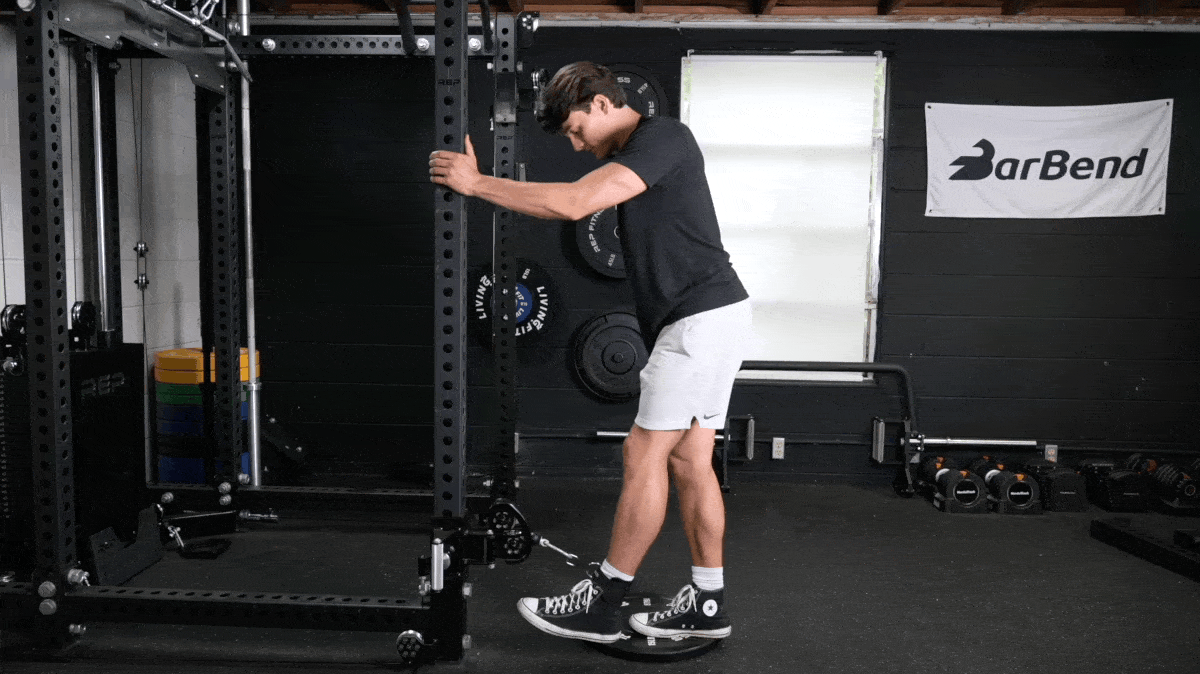
In this variation, your setup and technique are crucial to the success of the exercise and placing maximal tension where it needs to be. If you can get the angle right, the glute kickback offers unparalleled isolation to your behind through its entire contractile range of motion. Kickbacks make for top-tier finishers at the end of a workout.
How To Do It
[*]Place a strap attached to the cable around the ankle. Keep your back in a neutral position with your abs engaged.
[*]Tilt your body forward and kick your leg out behind you while maintaining a very slight bend in the knee.
[*]Raise your leg until you fully contract your working glute while keeping your non-working leg relaxed.
Coach’s Tip: Keep your knee straight — but not locked out — for the duration of your set.
Sets and Reps: Try 2 or 3 sets of as many as 15 repetitions to isolate your glutes.
11. Step-Up
If you aren’t keen for lunges or split squats but want to train your glutes unilaterally, you can grab a plyometric box or weight bench and smash some step-ups.
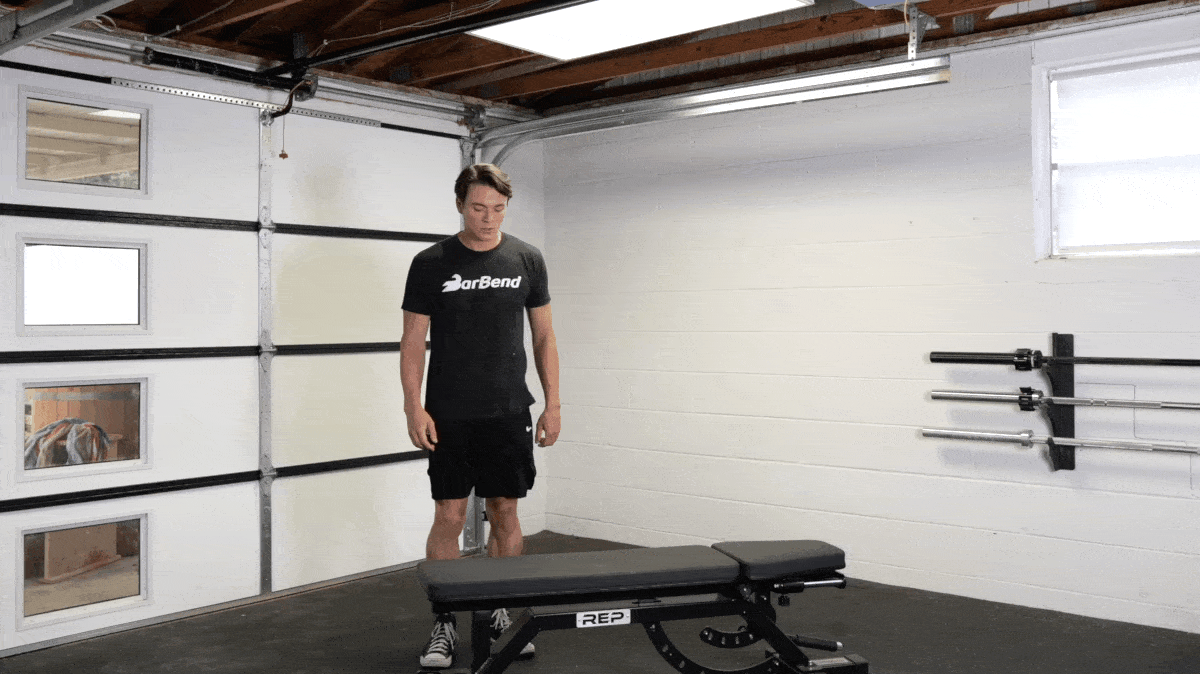
Due to the alignment of this exercise, you can place a lot of muscular tension on the glute max without external load. This is an exercise with many benefits and can be performed with little to no equipment. All you will need is a step-up box or bench.
How To Do It
[*]Start with one foot close to the edge of a knee-height step-up box or bench, ensuring the whole foot is in contact with the surface, with the other foot hanging off.
[*]Drop the foot to the ground, controlling your body weight with the opposite leg.
[*]Tap the heel of the foot to the ground and drive through the step with the working leg to return back to the starting position.
Coach’s Tip: The higher the surface you step to, the more you’ll engage your glutes due to the added range of motion.
Sets and Reps: Try 2 or 3 sets of as many as 12 to 15 repetitions.
12. Smith Machine Reverse Lunge
The smith machine reverse lunge is a stable lunge variation, allowing you to control the technique and better bias the target muscles.
https://youtu.be/JzrwCj4dVc0Video can’t be loaded because JavaScript is disabled: Smith Machine Front Foot Elevated Reverse Lunge to Step Up: How To (https://youtu.be/JzrwCj4dVc0)
The stability of this lunge makes it great for both beginners and advanced trainees who want to add weight to the movement — you’ll have an easier time loading this reverse lunge variation. As such, you can work your glutes through a large range of motion both safely and effectively.
How To Do It
[*]Stand with your feet together on an elevated surface, and position your body under the bar in the Smith machine.
[*]Unrack the weight and take a step back with one leg until it’s behind you and your knee is an inch or so above the floor.
[*]Your front leg should bend at a 90-degree angle as well. Drive through your front foot and stand back up with control.
Coach’s Tip: There’s no need to raise your non-working leg up at the top of each rep; there’s no load on that leg anyway.
Sets and Reps: Try 2 to 4 sets of 8 to 12 reps with a decently challenging weight.
13. Lateral Lunge
The lateral lunge is performed by stepping directly out to the side, then standing up to return to the starting position. The lateral lunge is awesome because it challenges the muscles around the hip that are responsible for internal and external rotation of the leg — most notably the glute medius and minimus.
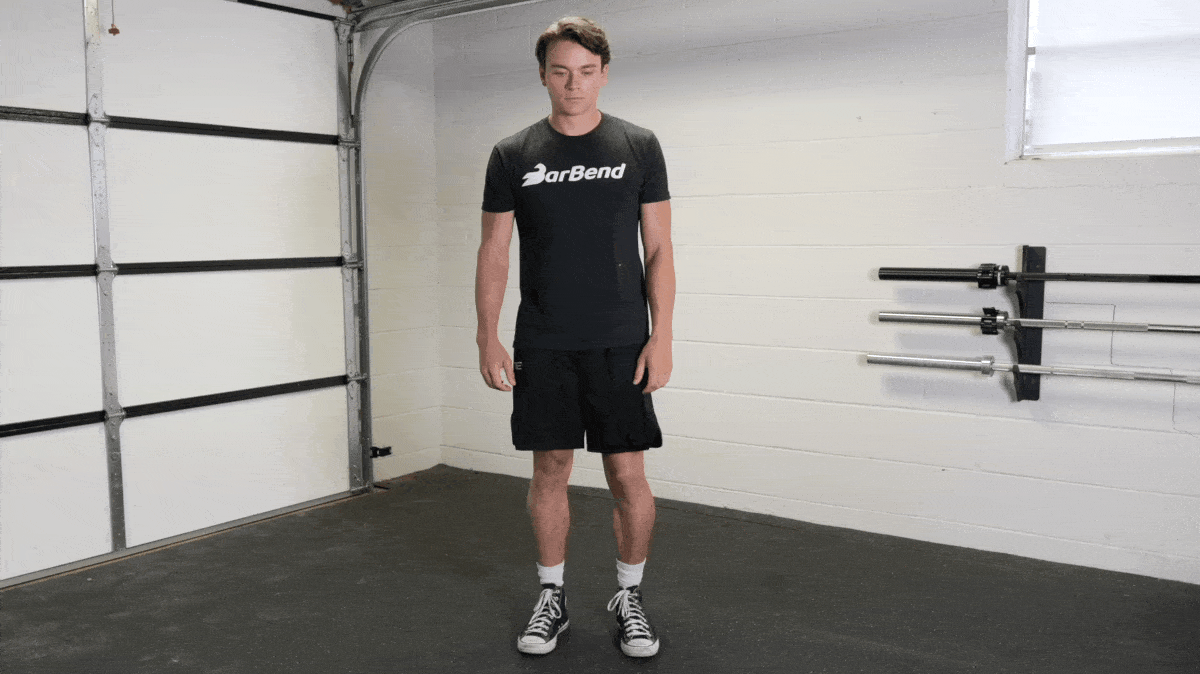
This exercise is also particularly valuable for strength athletes who tend to work in one plane of motion (the sagittal plane) exclusively. The lateral lunge can help diversify your lower-body stimulation and make you a more resilient athlete. You’ll also work one side of your body at a time, allowing lagging muscles to catch up.
How To Do It
[*]Take a step out to the side roughly 18 to 24 inches and plant your foot firmly to the ground.
[*]From there, allow your front knee to track forward while your body tracks outward to one side.
[*]Then, while driving through the floor with your lead foot, move your body back to the starting position.
Coach’s Tip: Your best bet is to work with a set of dumbbells at first for stability.
Sets and Reps: Try to complete 2-3 sets of 6-10 reps.
14. Goblet Squat
This front-loaded squat variation ensures that the lifter stays upright and is done with either dumbbells or kettlebells, making it manageable and more beginner-friendly. After mastering the bodyweight squat, the goblet version is an excellent transition into weighted squats for newer lifters.
https://youtu.be/CkFzgR55ghoVideo can’t be loaded because JavaScript is disabled: How to Perform Dumbbell Goblet Squat (https://youtu.be/CkFzgR55gho)
Goblet squats can be added to a larger group of exercises for more leg muscle and endurance for more advanced trainees. But the benefits for beginners are nearly endless; it’s easy to perform, encourages good posture, and serves as a great handshake to squatting in general.
How To Do It
[*]Stand with your feet around shoulder width apart with a dumbbell or kettlebell and hold the weight directly under your chin with your elbows tucked in.
[*]Brace your core, tense your back, and ensure that you feel stable.
[*]Keep your chest up and squat down until both of your legs bend to around 90 degrees. Stand back up by driving through the floor.
Coach’s Tip: Don’t rest the weight on your chest. Actively hold it aloft with your arms and upper back.
Sets and Reps: Go for 2 to 4 sets of 8 to 12 reps here.
15. Single-Leg Glute Bridge
Single-leg, or unilateral training is mighty difficult. Add some weight into the mix and things can get hairy, fast. The benefits of unilateral training can’t be overstated, though, particularly for the glutes.
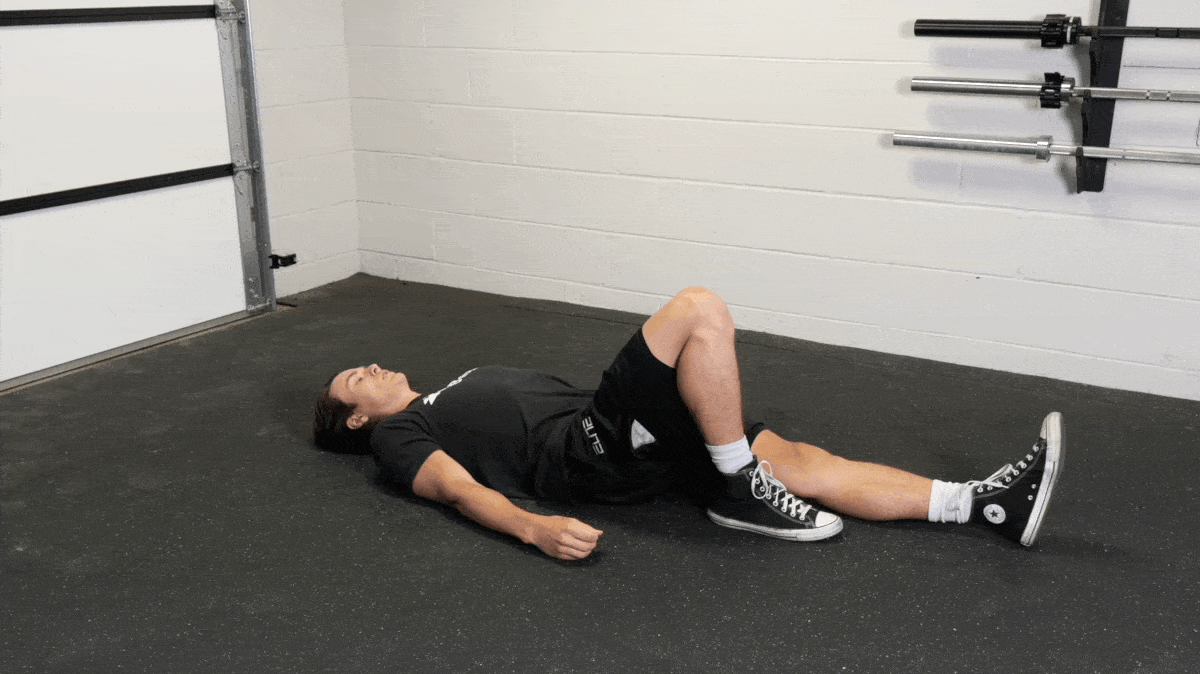
If split squats or curtsy lunges are more trouble than they’re worth, you might want to take things back to basics and try the single-leg bridge instead. This movement is equal parts glute-builder and technical drill, meant to teach you how to activate one individual glute at a time.
How To Do It
[*]Lie flat on your back on the floor with one leg bent and one leg straight.
[*]Push your bent-leg foot into the ground hard to raise your hips up into the air.
[*]Pause at the top, ensuring that there’s a straight line from your kneecap to your shoulders.
Coach’s Tip: You can bend your non-working knee while it is in the air to make this leg exercise a bit easier.
Sets and Reps: Try 1 to 2 sets of 5 to 10 reps with a slow tempo.
16. Good Morning
Hinge movements like the Romanian deadlift are diabolically effective at building your glutes. However, oftentimes you must use heavy weights to get the most value out of those movements.
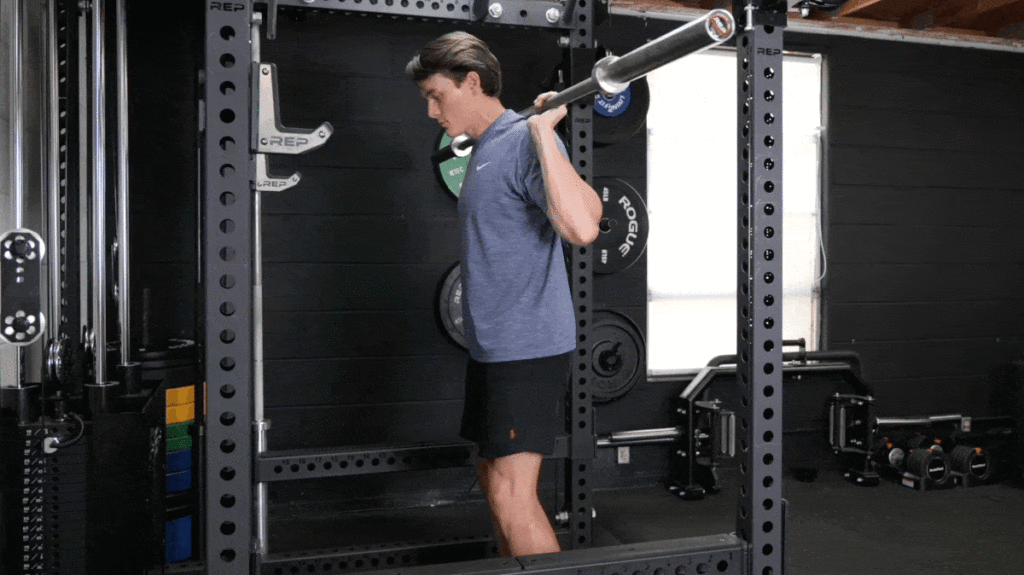
This isn’t the case for the good morning exercise. By placing the barbell on your back (instead of in your hands), the resistance ends up much further away from your glutes — making the reps much, much harder. This provides a two-for-one benefit — light weights feel heavy and stimulating, while also teaching you how to hinge properly with a braced core.
How To Do It
[*]Unrack a barbell from a squat stand or power rack as if you were going to perform a standard back squat.
[*]Take a close, hip-width stance, then slowly shoot your hips back behind you and descend into a low bow.
[*]Your torso should end up nearly parallel to the floor before you reverse the motion and squeeze your glutes to return to a standing position.
Coach’s Tip: Avoid training too close to failure on this exercise, as there’s no way to safely dump the weight off your back.
Sets and Reps: Try 2 sets of 8-12 reps with a moderate weight and slow tempo.
17. Kettlebell Swing
Kettlebells are renowned for their utility as a conditioning tool, but in the right hands, they can be amazing for building your glutes. The kettlebell swing is a two-for-one — you can break a gnarly sweat and get the glute pump of your life in the process.
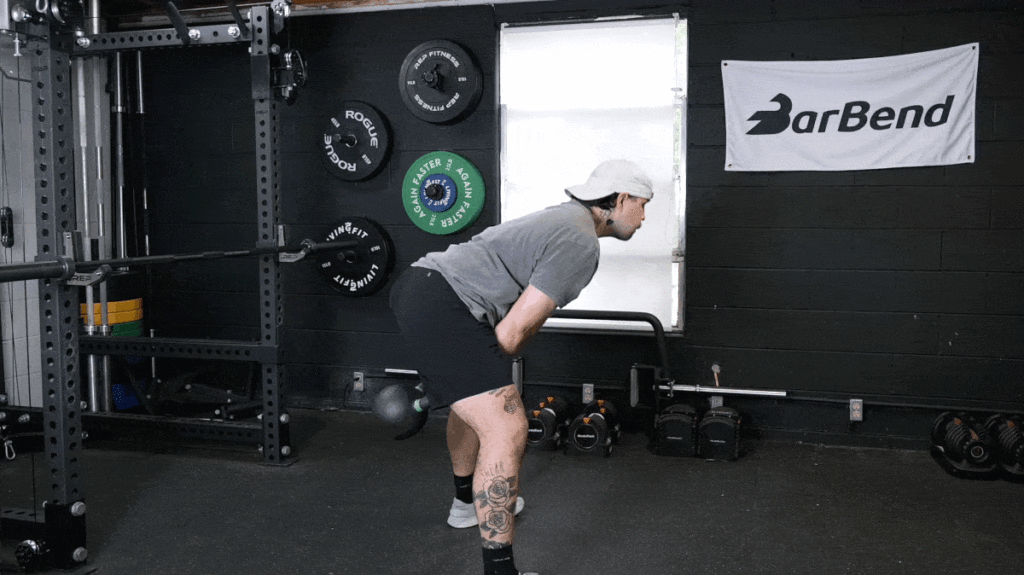
Swings pull you into a hinged position and require you to generate heaps of explosive power through your hips to finish the rep. This teaches you to flex your glutes rapidly, forcing blood into the muscle and accumulating tons of metabolic stress. The kettlebell swing works well as both a conditioning tool or for active recovery.
How To Do It
[*]Set up with a kettlebell between your feet with a shoulder-width stance or slightly wider.
[*]Hinge down to grab the kettlebell and sweep it back between your legs, and then rapidly thrust your hips forward.
[*]The momentum should naturally elevate the kettlebell upward to around belly button height. Allow the bell to fall naturally and kick your hips backward to recycle into the next repetition.
[*]String your reps together smoothly and you’re off to the races.
Coach’s Tip: Keep your arms relaxed and tucked to your sides. The height of the kettlebell is irrelevant to training your glutes.
Sets and Reps: Warm up your glutes with 4 sets of 15 to 20 repetitions.
Glutes Warm-Up
Don’t dive into your glute training without first diving into some proper mobility work. When you’re doing them right (slow, steady, deliberate, and possibly with a band), there’s nothing easy about glute work.
https://youtu.be/U4YQjqBERvkVideo can’t be loaded because JavaScript is disabled: Squat Warm Up | Seven Exercises to Prep From the Ground Up! (https://youtu.be/U4YQjqBERvk)
One of the most effective warm-ups for any muscle group is going to be the exercises you are performing in that day’s training session. For example, if you’re performing back squats, you can warm up by performing light reps and increase intensity as you proceed towards your working sets.
This ensures that the appropriate muscles and joints are being primed, reducing the risk of injury and improving your overall training performance. Here’s a sample warm-up you can use on your next glute-focused workout:
Four Glute Workouts To Try
Glute training has risen to prominence in the fitness world, but...
Click here to view the article.
The post The 17 Best Glute Exercises for Size, Strength, and Activation appeared first on BarBend.
The gluteus maximus — that’s your butt for the uninitiated — is the largest muscle in your body. Even if filling out a pair of jeans isn’t at the top of your priority list, bigger, stronger glutes will help you build better squats, deadlifts, and everything in between (yes, even overhead lifts). If you can’t figure out the most efficient way to activate your glutes, you’re just not going to be able to maximize your gains.
Here, you’ll learn why direct glute workout is more effective than the old “well, glutes are involved in squats and deads, so that should be enough.” If you really want to boost your performance in and out of the gym, you need the right glute exercises.
 Credit: BigBlueStudio / Shutterstock
Credit: BigBlueStudio / ShutterstockBut how do you know which glute exercises are best? You read this list and put the movements into action. Here are 17 of the best strength-and-muscle-building glute movements you can try on your next leg day.
17 Best Glutes Exercises
[*]Conventional Deadlift
[*]Back Squat
[*]Hip Thrust
[*]Belt Squat
[*]Banded Romanian Deadlift
[*]Rear Foot Elevated Split Squat
[*]Sumo Deadlift
[*]Modified Curtsy Lunge
[*]Walking Lunge
[*]Cable Glute Kickback
[*]Step-Up
[*]Smith Machine Reverse Lunge
[*]Lateral Lunge
[*]Goblet Squat
[*]Single-Leg Glute Bridge
[*]Good Morning
[*]Kettlebell Swing
Editor’s Note: The content on BarBend is meant to be informative in nature, but it should not be taken as medical advice. When starting a new training regimen and/or diet, it is always a good idea to consult with a trusted medical professional. We are not a medical resource. The opinions and articles on this site are not intended for use as diagnosis, prevention, and/or treatment of health problems. They are not substitutes for consulting a qualified medical professional.
1. Conventional Deadlift
The conventional deadlift — the king of all deadlift variations — is one of the most popular exercises around, and rightfully so. It challenges the muscles around the hip, knee, and ankle. It also taxes the muscles surrounding your wrist, elbow, and shoulder to hold the barbell, but those joints do not contribute directly to the range of motion.

[Related More: Romanian Deadlift Vs. Deadlift — Which is Better for Your Program?]
As it has a primary focus on hip extension, you can do deadlifts while training back, legs, or anywhere else it fits nicely in your programming. The raw mechanical tension applied to your backside is unrivaled by most other weight room exercises as well.
How To Do It
[*]Set up for the deadlift by taking a hip-width stance, hinging at the hips, shooting your butt back, and reaching down to the barbell.
[*]Grab the bar with a close grip, just outside your shins.
[*]Flatten your back, pull your chest up, and take a breath in.
[*]Push into the floor with your legs to break the bar off the ground.
[*]As the bar passes your knees, thrust your hips forward and squeeze your glutes to come to a standing position.
Coach’s Tip: Take some time to experiment with your starting position to find something that really engages your glutes.
Sets and Reps: For glute growth specifically, try 3-4 sets of 5-8 reps.
2. Back Squat
The back squat is a compound exercise that challenges every muscle in the legs, especially the glutes. Its primary use in training is to challenge hip extension, driving the lower body up from the bottom position and placing a high amount of tension on the glutes.

[Read More: The 8 Best Knee Sleeves You Can Buy]
The back squat leads to strength and muscle gain and reinforces other exercises like the deadlift, split squat, and lunge. It also recruits the core and improves your posture.
How To Do It
[*]Unrack a bar from a squat rack by placing it on your upper back with a close grip and taking one or two steps back.
[*]Take a comfortable stance; place your feet between hip and shoulder-width apart and turn your feet outward to whatever angle feels natural.
[*]From here, inhale into your belly and feel your weight distribute evenly across your feet.
[*]Squat by breaking at your knees and hips simultaneously and sitting down as low as you’re able.
[*]Once you reach the bottom, reverse the motion and stand back up by contracting your quads.
Coach’s Tip: Squat depth is the most important factor when it comes to engaging your glutes. Try to squat as low as you can with good form.
Sets and Reps: Go for 3-4 sets of 6-8 reps with a challenging weight.
3. Hip Thrust
This exercise is very effective at loading the glutes in their shortened position, without the need to load the spine. What separates the glute bridge from the hip thrust is the range of motion.

Folks typically perform glute bridges on the floor, which limits how much you can flex your hips and makes using heavy weights somewhat awkward. Hip thrusts require you to sit up against a bench and offer more range of motion to blast your glutes with. What’s more, thrusts let you apply lots of heavy tension to your glutes while leaving your lower back almost entirely out of the equation.
How To Do It
[*]Sit with your upper back against a weight bench and a loaded barbell in front of you. Roll the bar back until it brushes up your hips.
[*]Bend your knees and plant your feet on the floor to seal the bar into your hip crease. Grab the bar with a wide grip.
[*]Initiate the thrust by pushing your hips upward until your body forms a straight line from your kneecaps to your shoulders.
Coach’s Tip: You should absolutely place a protective pad on the barbell here to avoid crushing your hips and groin.
Sets and Reps: Do 4-5 sets of 8-12 reps here to grow your glutes.
4. Belt Squat
This unique squat variation uses a machine to help load the lower body, without the need to place more load on the low back and spine. It’s popular across all levels of fitness, including among bodybuilders, powerlifters, and weightlifters for building muscle and strength in the quads and glutes.
https://youtu.be/oAK7QmugOzUVideo can’t be loaded because JavaScript is disabled: How To Dramatically Improve Your Squat WITHOUT Loading The Spine | Matt Wenning Belt Squat (https://youtu.be/oAK7QmugOzU)
[Read More: The Big Guide to Muscle Hypertrophy]
The positioning of the load in the belt squat allows for a more vertical spine, taking some of the load off the low back, and increased training volume without more wear and tear since the weight is pulling your hips down rather than pressing on your torso.
How To Do It
[*]Stand on the platform and fasten the belt around your hips.
[*]Place your feet to the left and right of the pulley in the platform and place your hands on the handles in front of you.
[*]Engage the pulley system and find your balance. Take a breath into your belly.
[*]Sit straight down, allowing the pulley to guide your movement.
[*]Squat as low as you comfortably can and then push back up to a standing position.
Coach’s Tip: Think about allowing the pulley system to pull your hips straight down into the bottom of the squat.
Sets and Reps: Try 2-3 sets of 8-12 reps here with a moderate weight.
5. Banded Barbell Romanian Deadlift
This variation helps add tension to the glutes in the standing position — a position where there is usually no resistance. The resistance band helps give a counterbalance to your torso and allows you to lean forward into the movement. It also gives you an external cue to help you bend your hips rather than rounding at the low back, improving your hip-hinging abilities.

[Read More: The Single-Leg Deadlift Is the Best Pulling Accessory You’re Not Doing]
The horizontal band position can help increase the load placed on the muscles across the range of motion. You can also use the band as a tactile cue — it pulls your hips backward, naturally encouraging you to fall into a picture-perfect hip hinge, and adds some much-needed tension to the top portion of the exercise.
How To Do It
[*]Fasten a resistance band to a support structure at waist height behind you, wrap it around your hips, and step forward until there is moderate tension in the band.
[*]Bend over to pick up a lightly-loaded barbell and assume a close hip-width stance.
[*]Hinge at the hips, allowing the band to pull your pelvis backward until you feel a strong stretch in your posterior chain. Let the barbell glide down your thighs.
[*]Fight the band and thrust your hips forward to return to a standing position.
Coach’s Tip: The band should not be tense enough that you lose your balance. Use it to cue forceful hip extension.
Sets and Reps: Try 2 sets of 12-15 reps here with a moderate weight.
6. Rear-Foot-Elevated Split Squat
A close relative to the Bulgarian split squat, this variation isolates one leg at a time, which also allows a weaker leg the ability to catch up in terms of size and strength.

The rear foot elevation allows you to sink down into hip flexion more, placing more muscular tension on the glute of the front leg. It’s also a phenomenal exercise for identifying and attacking any side-to-side discrepancies in strength or motor control, improving your balance as you beef up your backside.
How To Do It
[*]Place your non-working leg onto a knee-height bench or box about two feet behind you.
[*]Balance yourself on your working leg with a weight in each hand.
[*]From here, sink your hips down and back, allowing your working leg knee to bend and travel forward as needed.
[*]Reverse the motion by pushing into the floor until your leg is straight.
Coach’s Tip: To emphasize your glutes even more, limit how far forward your knee travels over your toes.
Sets and Reps: Try 2 or 3 sets of 8 to 12 reps with as much weight as you can maintain good form with.
7. Sumo Deadlift
The sumo deadlift is a widely-used exercise with many benefits, especially when it comes to adding strength and size to the lower body. This deadlift variation requires a wider stance compared to the conventional setup, with the feet turned out quite significantly in some cases. Powerlifters “pull sumo” to lift the heaviest weights possible in competition, but it’s a darn good exercise for shaping your glutes even if you aren’t a strength athlete.

[Read More: Get Freakishly Strong With the 5×5 Workout Program]
The ultra-wide stance places the hips into external rotation, placing tension on the adductor and glute muscles — most notably the smaller glute medius and minimus. Most people can maintain a more upright torso with the sumo deadlift as well, which is beneficial if you want to minimize loading on your lumbar spine.
How To Do It
[*]Address a loaded barbell by taking a very wide, toes-turned-out stance. Point your feet towards the weight plates and open your hips.
[*]From here, break at the hips and sink down until you can grab the bar with both hands.
[*]Brace for the pull by inhaling air into your stomach, pushing your knees out to the sides, and pulling your chest up.
[*]Initiate the movement by pushing into the floor with your legs and standing up until you can lock your hips out.
Coach’s Tip: The sumo deadlift has no eccentric phase. Keep your hands on the bar but allow it to fall freely to the floor between reps.
Sets and Reps: Try 3-4 sets of 3-6 reps with a heavy weight.
8. Modified Curtsy Lunge
The modified curtsy lunge is a lunge variation that reinforces glute medius and minimus engagement. In this exercise, the lifter sets up in a modified split squat stance with an elevated back foot and the lead foot rotated internally around 10-20 degrees.
https://youtu.be/bQV7qr8tt4MVideo can’t be loaded because JavaScript is disabled: Backfoot Elevated Modified Curtsy Lunge (Glute Medius) (https://youtu.be/bQV7qr8tt4M)
[Read More: The Ultimate 10-Week Powerbuilding Workout Routine for Mass and Strength]
The glute medius is worked through a greater range of motion while better aligning the body with the desired movement pattern. Additionally, the rear foot elevation increases hip flexion and allows you to place more load on your front leg than during a standard lunge.
How To Do It
[*]Stand with a dumbbell in each hand, and place one foot, toes down, on an elevated surface behind you.
[*]The lead foot rotated internally around 10-20 degrees, aligning with the toes of the lead foot with the knee of the back leg.
[*]With a slight lean forward in your torso, squat down until both of your legs bend to around 90 degrees.
[*]Stand back up by driving your front foot through the floor.
Coach’s Tip: Balance should be your priority here. If you can’t balance yourself, you can’t focus on engaging your glutes.
Sets and Reps: Try 1 or 2 sets of 10-15 reps depending on how well you can balance yourself.
9. Walking Lunge
The walking lunge is a great variation to employ because the step adds a level of focus on balance and coordination, so athletes will often use this as a dynamic lower body exercise option to train the muscles of the posterior chain.
https://youtu.be/RqimDHU-tkgVideo can’t be loaded because JavaScript is disabled: Lunge Guide | How To, Variations, Benefits, and More (https://youtu.be/RqimDHU-tkg)
[Read More: 10 Science-Backed Benefits of Walking for Strength Athletes]
Alongside its myriad of benefits for balance and coordination, it challenges the glutes through a large and dynamic range of motion, making it a go-to glute builder. What’s more, the walking lunge is effective using bodyweight only, making it beginner-friendly. Advanced lifters can load up this lunge variation using a variety of free weights: Dumbbells, kettlebells, barbells, sandbags, or a safety squat bar.
How To Do It
[*]Stand with your feet together, and then take a step forward roughly 18 to 24 inches and plant your foot firmly to the ground.
[*]From there, you will allow your front knee to track forward — aiming between the first and second toe — while your back knee drops straight down to the ground.
[*]While driving through the floor with your front foot, move your body forward to a standing position, where your back foot will meet the position of the front one.
Coach’s Tip: Pace yourself here and don’t rush your steps, walking lunges challenge your cardio as much as anything else.
Sets and Reps: Try 2 or 3 rounds of lunges walking for about 10 steps per leg.
10. Cable Glute Kickback
Glute kickbacks are devilishly effective at growing your glutes because they isolate the muscle; a quality you can’t often find without turning to machines or cables. Depending on your set up, you can effectively challenge the glute medius or glute maximus.

In this variation, your setup and technique are crucial to the success of the exercise and placing maximal tension where it needs to be. If you can get the angle right, the glute kickback offers unparalleled isolation to your behind through its entire contractile range of motion. Kickbacks make for top-tier finishers at the end of a workout.
How To Do It
[*]Place a strap attached to the cable around the ankle. Keep your back in a neutral position with your abs engaged.
[*]Tilt your body forward and kick your leg out behind you while maintaining a very slight bend in the knee.
[*]Raise your leg until you fully contract your working glute while keeping your non-working leg relaxed.
Coach’s Tip: Keep your knee straight — but not locked out — for the duration of your set.
Sets and Reps: Try 2 or 3 sets of as many as 15 repetitions to isolate your glutes.
11. Step-Up
If you aren’t keen for lunges or split squats but want to train your glutes unilaterally, you can grab a plyometric box or weight bench and smash some step-ups.

Due to the alignment of this exercise, you can place a lot of muscular tension on the glute max without external load. This is an exercise with many benefits and can be performed with little to no equipment. All you will need is a step-up box or bench.
How To Do It
[*]Start with one foot close to the edge of a knee-height step-up box or bench, ensuring the whole foot is in contact with the surface, with the other foot hanging off.
[*]Drop the foot to the ground, controlling your body weight with the opposite leg.
[*]Tap the heel of the foot to the ground and drive through the step with the working leg to return back to the starting position.
Coach’s Tip: The higher the surface you step to, the more you’ll engage your glutes due to the added range of motion.
Sets and Reps: Try 2 or 3 sets of as many as 12 to 15 repetitions.
12. Smith Machine Reverse Lunge
The smith machine reverse lunge is a stable lunge variation, allowing you to control the technique and better bias the target muscles.
https://youtu.be/JzrwCj4dVc0Video can’t be loaded because JavaScript is disabled: Smith Machine Front Foot Elevated Reverse Lunge to Step Up: How To (https://youtu.be/JzrwCj4dVc0)
The stability of this lunge makes it great for both beginners and advanced trainees who want to add weight to the movement — you’ll have an easier time loading this reverse lunge variation. As such, you can work your glutes through a large range of motion both safely and effectively.
How To Do It
[*]Stand with your feet together on an elevated surface, and position your body under the bar in the Smith machine.
[*]Unrack the weight and take a step back with one leg until it’s behind you and your knee is an inch or so above the floor.
[*]Your front leg should bend at a 90-degree angle as well. Drive through your front foot and stand back up with control.
Coach’s Tip: There’s no need to raise your non-working leg up at the top of each rep; there’s no load on that leg anyway.
Sets and Reps: Try 2 to 4 sets of 8 to 12 reps with a decently challenging weight.
13. Lateral Lunge
The lateral lunge is performed by stepping directly out to the side, then standing up to return to the starting position. The lateral lunge is awesome because it challenges the muscles around the hip that are responsible for internal and external rotation of the leg — most notably the glute medius and minimus.

This exercise is also particularly valuable for strength athletes who tend to work in one plane of motion (the sagittal plane) exclusively. The lateral lunge can help diversify your lower-body stimulation and make you a more resilient athlete. You’ll also work one side of your body at a time, allowing lagging muscles to catch up.
How To Do It
[*]Take a step out to the side roughly 18 to 24 inches and plant your foot firmly to the ground.
[*]From there, allow your front knee to track forward while your body tracks outward to one side.
[*]Then, while driving through the floor with your lead foot, move your body back to the starting position.
Coach’s Tip: Your best bet is to work with a set of dumbbells at first for stability.
Sets and Reps: Try to complete 2-3 sets of 6-10 reps.
14. Goblet Squat
This front-loaded squat variation ensures that the lifter stays upright and is done with either dumbbells or kettlebells, making it manageable and more beginner-friendly. After mastering the bodyweight squat, the goblet version is an excellent transition into weighted squats for newer lifters.
https://youtu.be/CkFzgR55ghoVideo can’t be loaded because JavaScript is disabled: How to Perform Dumbbell Goblet Squat (https://youtu.be/CkFzgR55gho)
Goblet squats can be added to a larger group of exercises for more leg muscle and endurance for more advanced trainees. But the benefits for beginners are nearly endless; it’s easy to perform, encourages good posture, and serves as a great handshake to squatting in general.
How To Do It
[*]Stand with your feet around shoulder width apart with a dumbbell or kettlebell and hold the weight directly under your chin with your elbows tucked in.
[*]Brace your core, tense your back, and ensure that you feel stable.
[*]Keep your chest up and squat down until both of your legs bend to around 90 degrees. Stand back up by driving through the floor.
Coach’s Tip: Don’t rest the weight on your chest. Actively hold it aloft with your arms and upper back.
Sets and Reps: Go for 2 to 4 sets of 8 to 12 reps here.
15. Single-Leg Glute Bridge
Single-leg, or unilateral training is mighty difficult. Add some weight into the mix and things can get hairy, fast. The benefits of unilateral training can’t be overstated, though, particularly for the glutes.

If split squats or curtsy lunges are more trouble than they’re worth, you might want to take things back to basics and try the single-leg bridge instead. This movement is equal parts glute-builder and technical drill, meant to teach you how to activate one individual glute at a time.
How To Do It
[*]Lie flat on your back on the floor with one leg bent and one leg straight.
[*]Push your bent-leg foot into the ground hard to raise your hips up into the air.
[*]Pause at the top, ensuring that there’s a straight line from your kneecap to your shoulders.
Coach’s Tip: You can bend your non-working knee while it is in the air to make this leg exercise a bit easier.
Sets and Reps: Try 1 to 2 sets of 5 to 10 reps with a slow tempo.
16. Good Morning
Hinge movements like the Romanian deadlift are diabolically effective at building your glutes. However, oftentimes you must use heavy weights to get the most value out of those movements.

This isn’t the case for the good morning exercise. By placing the barbell on your back (instead of in your hands), the resistance ends up much further away from your glutes — making the reps much, much harder. This provides a two-for-one benefit — light weights feel heavy and stimulating, while also teaching you how to hinge properly with a braced core.
How To Do It
[*]Unrack a barbell from a squat stand or power rack as if you were going to perform a standard back squat.
[*]Take a close, hip-width stance, then slowly shoot your hips back behind you and descend into a low bow.
[*]Your torso should end up nearly parallel to the floor before you reverse the motion and squeeze your glutes to return to a standing position.
Coach’s Tip: Avoid training too close to failure on this exercise, as there’s no way to safely dump the weight off your back.
Sets and Reps: Try 2 sets of 8-12 reps with a moderate weight and slow tempo.
17. Kettlebell Swing
Kettlebells are renowned for their utility as a conditioning tool, but in the right hands, they can be amazing for building your glutes. The kettlebell swing is a two-for-one — you can break a gnarly sweat and get the glute pump of your life in the process.

Swings pull you into a hinged position and require you to generate heaps of explosive power through your hips to finish the rep. This teaches you to flex your glutes rapidly, forcing blood into the muscle and accumulating tons of metabolic stress. The kettlebell swing works well as both a conditioning tool or for active recovery.
How To Do It
[*]Set up with a kettlebell between your feet with a shoulder-width stance or slightly wider.
[*]Hinge down to grab the kettlebell and sweep it back between your legs, and then rapidly thrust your hips forward.
[*]The momentum should naturally elevate the kettlebell upward to around belly button height. Allow the bell to fall naturally and kick your hips backward to recycle into the next repetition.
[*]String your reps together smoothly and you’re off to the races.
Coach’s Tip: Keep your arms relaxed and tucked to your sides. The height of the kettlebell is irrelevant to training your glutes.
Sets and Reps: Warm up your glutes with 4 sets of 15 to 20 repetitions.
Glutes Warm-Up
Don’t dive into your glute training without first diving into some proper mobility work. When you’re doing them right (slow, steady, deliberate, and possibly with a band), there’s nothing easy about glute work.
https://youtu.be/U4YQjqBERvkVideo can’t be loaded because JavaScript is disabled: Squat Warm Up | Seven Exercises to Prep From the Ground Up! (https://youtu.be/U4YQjqBERvk)
One of the most effective warm-ups for any muscle group is going to be the exercises you are performing in that day’s training session. For example, if you’re performing back squats, you can warm up by performing light reps and increase intensity as you proceed towards your working sets.
This ensures that the appropriate muscles and joints are being primed, reducing the risk of injury and improving your overall training performance. Here’s a sample warm-up you can use on your next glute-focused workout:
- 5-10 minutes on the incline treadmill, stair climber, or elliptical
- 2 sets of 15-20 banded side shuffles, unweighted step-ups, or bridges
- 1-2 sets of your first compound exercise with the empty bar or light dumbbells
Four Glute Workouts To Try
Glute training has risen to prominence in the fitness world, but...
Click here to view the article.




